

The following checklist for Wisconsin was sent to me by Jeff Crolla. The list was compiled in 2000 (Ferge & Balogh). I have added Catocala alabamae and Catocala residua, based on Hugo L. Kons Jr., Robert J. Borth, and Thomas S. Barina checklist posted on the Web 24 August 2007. The latter list does not include Catocala innubens.
I have rearranged the order, grouping by size and hindwing colour.
In most cases the hindwings can be viewed in the individual species files. They are sometimes diagnostic.
As of April 4, 2010, this page has been further updated as per research data compiled by Larry Gall.
I would like to continue to refine the listings to county levels so images and data (date, location at least to county level,
bait, lights) would be very much appreciated. Please send same to Bill Oehlke.
All images that I use on my websites remain the property of respective photographers and images are credited as such.
The Identification Keys Diagram should help you understand the terminology I have used in describing the various species.
Many thanks to Carroll Rudy and Joan F. Rickert who have sent me images and data for Wisconsin counties.
Many thanks also to Ian Miller who sends data for Eau Claire County. Kate Redmund has sent some images and data from Ozuakee County.
Many thanks to Marcie O'Connor of Buffalo County. Marcie has sent images and data to help build the data base for Wisconsin. Marcie has a very nice website at http://www.aprairiehaven.com/?page_id=10023 where you can see moths of many different families. Visit Wisconsin Sphingidae.
Little Yellow-Orange Underwings: Wingspans: 30-45mm
Little Yellow-Orange Underwings: Wingspans: 35-56mm |

| ** 8876 Catocala micronympha, the Little Nymph Underwing, (wingspan: 35-50mm). John Himmelman image. Usual specimens have grey forewings shaded with green, brown, black and white tints. Usually a darkened band passing from costa through reniform spot to outer margin. High variability. Full size Joe Garris photo of C. micronympha form hero. |

| ** 8876 Catocala micronympha
form gisela,
the Little Nymph Underwing, (wingspan: 35-50mm). |

| ** 8876 Catocala micronympha
form hero,
the Little Nymph Underwing, (wingspan: 35-50mm).
The usual specimens have grey forewings shaded with green, brown,
black and white tints. There is usually a darkened band passing from
the costa through the reniform spot to the outer margin.
Form "hero" H. Edwards has a median area that is mostly white. |

| ** 8876 Catocala micronympha form lolita, the Little Nymph Underwing, (wingspan: 35-50mm).Form "lolita" Sargent has very dark forewings. Harold J. Vermes image, used with permission from his son. |
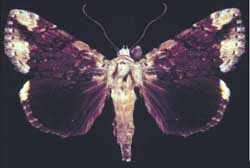
| ** 8876 Catocala micronympha form sargenti, the Little Nymph Underwing, (wingspan: 35-50mm). Usual specimens have grey forewings shaded with green, brown, black and white tints. Usually a darkened band passing from costa through reniform spot to outer margin. Form "sargenti" Covell (very rare) has a hindwing that is all black. |

| ** 8877 connubialis, Connubial Underwing, 35-50mm. Fw is highly variable, there are several different forms: "sancta" Hulst: typical form, has forewings with white ground colour & sharply contrasting black lines & markings. There is also brown shading between post medial & subterminal lines; "cordelia" H. Edwards: coloured as above but markings are faint; "pulverulenta" Brower: grey-green forewings with faint markings, sometimes none; "broweri" Muller: forewings that are dark green, almost black. Hw has separate anal spot & outer band ends with straight cut. Leroy Simon image. |

| ** 8864 Catocala grynea ; Woody Underwing, 40-50mm |

| ** 8865
praeclara; Praeclara Underwing, 40-50mm |

| ** 8867 Catocala blandula;
Charming Underwing, 40-50mm. |

| Catocala mira; Wonderful Underwing, 40-50mm. Pale basal area of fw distinguishes mira from blandula (dark brown) and crataegi (black). Fw lacks dark contrasting lines of crataegi & blandula. There is also considerable brown in subterminal area & subreniform spot is very conspicuous & usually brown. Light area runs obliquely from costa to subreniform spot. There is a noticeable space along im between am & postmedial lines. Hw is deep orange with complete inner black band. The outer black band is unbroken Tim Dyson image. |

| ** 8858 Catocala crataegi WO; Hawthorn Underwing, 40-50mm. Determination is based on dark (black) shading in forewing basal area continuing along inner margin to anal angle and brown shading beyond postmedial line. There is also a definite greenish cast to median area. hw has outer black band, broken near anal angle, distinguishing crataegi from blandula. Tim Dyson image. |

| ** 8841 Catocala abbreviatella; Abbreviated Underwing; 40-50mm. Fw uniformly colored with narrow black lines on anterior half. Brown reniform spot ringed with black. Outer black band of hw abbreviated, then a dot. Inner black band terminates well before im. Similar species: Catocala nuptialis, solid black reniform spot. C. whitneyi, broad dark triangles mid fw. |

| ** 8842 Catocala nuptialis;
Maried Underwing, wingspan 40-50mm. |

| ** 8843 whitneyi; Whitney's Underwing, 43-50mm. Catocala whitneyi is similar to abbreviatella Grote, & nuptialis Walker, but generally flies later in the season where species overlap. Two black wedges/triangles on forewing, one over reniform spot and other just outside antemedial line, distinguish whitneyi. Gerald Fauske image. |
 |
** 8844 amestris; Three-staff Underwing; 45-50mm. There is a large pale patch near the apex. In form "westcotti" the hindwing outer black band is complete. In other moths, the band is broken as in abbreviatella. Hindwing ground colour is usually deeper yellow-orange than in similar species. Leroy Simon image. |

| ** 8775 antinympha; Sweetfern Underwing, 45-55mm. Very dark grey, almost black, forewing ground colour distinguishes antinympha. There is some brown shading in subreniform spot and also just outside postmedial line. The hindwing is amber to pale orange. There is form multoconspicua Reiff, 1919 with a pale, almost white subreniform spot. Tim Dyson image. |

| ** 8772 clintoni; Clinton's Underwing, wingspan 45-55mm.The black basal dash distinguishes clintoni from illecta and abbreviatella, both of which lack the dash. Vernon Brou image. |

| ** 8776 badia coelebs; Old Maid Underwing, wingspan 54-56mm.The gray region from the forewing pm line to the outer margin readily distinguishes this species. The fringe is gray on the lower wing from the brief orange dash at the hindwing apex to the anal angle. Tim Dyson image. |
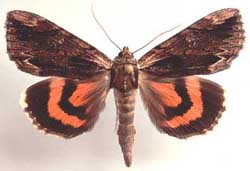
| ** 8857 Catocala ultronia; Ultronia Underwing, wingspan: 50-63mm.Fws typically gray-brown, with a distinct and very dark inner margin and characteristic light brown patch, underscored by very dark arc, near wingtip. Underwings can be yellow to orange to salmon. |
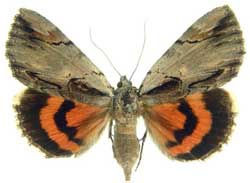
| ** 8857 Catocala ultronia form lucinda; Ultronia Underwing, wingspan: 50-63mm.In form lucinda most of the forewing is bright grey. On all forms there is
extensive orange-salmon colouration on hw ventral surface,
and there is a dark discal lunule. |
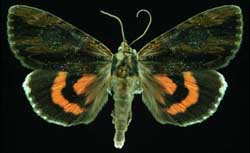
| Catocala ultronia, form nigrescens, the Ultronia Underwing, wingspan: 50-63mm. In the melanic form nigrescens, the dorsal forewing is very dark. Even darker subapical arc, basal dash and dash near anal angle are still visible. Dark basal hairs on hindwing. Harold J. Vermes slide, used with permission from his son. |
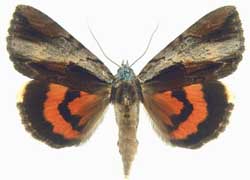
| Catocala ultronia form celia.
In form celia there is a wide, light grey band separating a dark region along inner margin and
a dark patch near the apex.
The ventral surface of forewings of all forms has a generous suffusion
of orange-salmon scales in the lower half of the median area. |
 |
** 8779 serena Serene Underwing. Head & collar & abdomen are brown while thorax is grey. Am & pm lines are thin, very dark, distinct on an otherwise drab, almost uniformly olive-grey fw. Black marginal band of lower wings is indented at center, relatively narrow, deep yellow median band parallels indentation. Basal hairs are brown. Catocala serena courtesy of Carroll Rudy, July 28, Calumet County. |

| #8778 Catocala habilis; 55-65mm. Note large "M" on thorax & "pork chop" shaped, light coloured subreniform spot becoming very dark in constriction at juncture with pm line. Pm line narrow, dark, distinct & outwardly lined with narrow suffusion of white scales, followed by broader band of brown scales, & broader suffusion of white scales up to regular dentation of st line. Significant "bleeding" of yellow-orange to salmon scales into hw fringes. Large reniform spot has brown center, faintly edged with black, then white, then black again. |

| #8817 briseis; Briseis Underwing; 60-70mm. Fws predominantly mottled dark-grey-brown with some lighter areas 1) between postmedial & subterminal lines, 2) at base of antemedial and postmedial lines along inner margin, and 3) over subreniform spot running diagonally toward costa. Pm lines do not have greatly elongated and sharly pointed "teeth" near apex. Hw fringe white and unbroken and inner black band (fairly even) reaches inner margin. Tim Dyson image. |

| #8795 Catocala palaeogama ; 60-70mm. Subreniform spot closed, does not approach pm line, smaller than habilis. All forms have characteristic orange, heavily barred fringe to apex, & irregular bands on hws. Hw basal median area heavily suffused with dark brown to black scales. Dark bar in outer half of median area, paralleling inner margin halfway between imn and light, closed subreniform spot. |

| #8795 Catocala palaeogama
form phalanga; 60-70mm.
In this form, the forewing basal area and subterminal
area are very dark against a much lighter background.
|

| ** 8770 Catocala innubens; Betrothed; 55-72mm. Forewing is mottled with white, grey and brown, and subrenifrom spot tends to be lighter in colour, although it is sometimes obscured by an indistinct blackish bar which runs from middle of basal/thorax connection to just below much lighter apex at outer margin.Jim Vargo image. |
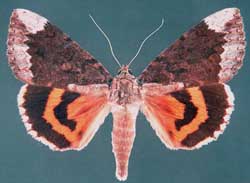
| ** 8770 Catocala innubens form scintillans; Betrothed; 55-72mm.In form scintillans most of the basal area (all but lower third) and all of the median area of the forewing is dark reddish brown. The area outside the pm line is grey. Vernon A Brou image. |

| ** 8851 Catocala coccinata; Scarlet; 57-70mm. Usually diffuse basal & anal dashes on otherwise light grey, mottled fw. Hw fringe is white (often with some salmon scaling) and is heavily checked. "Tooth" just below pair of elongated "teeth" is much reduced & quite rounded, usually allowing considerable room for lighter patch of scales. Dark bar crosses thorax. Reniform spot light, often with greenish cast. |

| ** 8840
Catocala illecta;
Magdalen Underwing, wingspan: 60-70mm |
Solid Black Underwings: Smallest to Largest, Similar Species Paired

| ** 8781 judith, Judith's Underwing, 45-55mm, is one of smaller "black" underwings. Fw is uniform light grey with thin and only slightly darkened antemedial, median & postmedial lines. No darkened dashes (slight anal dash) or transverse lines. The reniform area is slightly darkened while the area just before the subterminal line is a bit lighter. Note absence of hw white fringe. Joe Garris photo. |

| ** 8773
Catocala epione , yes;
Epione Underwing, wingspan: 55-65mm |

| Catocala retecta; 60-75mm. Note light coloured, elongated, open subreniform spot which interrupts dark, diffuse ark running through center of wing from basal area (body-wing juncture) to forewing apex. Center of reniform spot is brown and there is a brown area just below costa running to inner margin just outside pm line. Off-white hindwing fringe is only lightly checked along wing veins. Joe Garris image. |
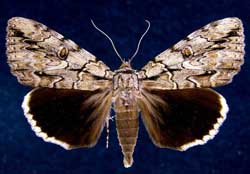
| Catocala luctuosa, Underwing, (wingspan: 70mm). Fw light grey (yellowish tint) clearly marked with a basal dash that continues with another dash through the am line, followed by another anal dash almost forming bar parallel to im. Hw fringe white, lightly barred at veins. Fw pml "teeth" elongated and dark, continuing dark dar emanating from om just below apex. |

| ** 8784 obscura; the Obscure Underwing, 60-72mm, has dull, grey forewings, usually void of any significant dashes or streaks, providing for easy identification. The antemedial, median and postmedial lines of obscura are faint and the subterminal line region is only slightly paler than the rest of the forewing. The hindwing fringe is off-white and lightly checked on the veins. Joe Garris photo. |

| Catocala residua,
Residua Underwing, yes, (wingspan: 58-73mm),
Distinguished from C. obscura by grey hindwing
fringe of residua.
C. obscura has white to off-white fringe, tends to be
less common in northern portions of its range. Fw
subterminal line/area of C. residua tends to be pale as
is its open, elongated subreniform spot. |

| ** 8783 Catocala angusi
WO; Angus' Underwing, 60-74mm. |
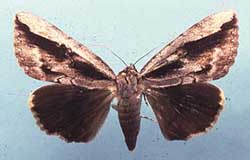
| ** 8783 Catocala angusi WO; Angus' Underwing, 60-74mm; Dark dashes/streaks in basal & anal areas. Reniform spot: light brown filling. Hw fringe black except for white region at apex. Form lucetta has broad black band from basal area to om, broken only by reniform & subreniform spots. James K. Adams image. |
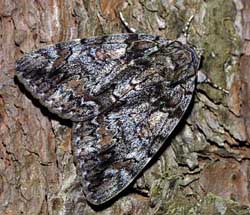
| ** 8794
Catocala lacrymosa;
Tearful Underwing, 60-82mm.
The forewing is highly variable with a mixture of black, brown
(wing tips and outside postmedial line) and dark grey scaling.
There are usually whitish crescents, along the inner margin at the
base of the antemedial and postmedial lines. |
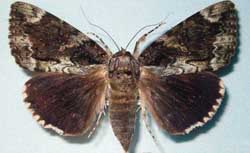
| ** 8794
Catocala lacrymosa;
Tearful Underwing, 60-82mm.
Form paulina: lighter grey post median area & area along and parallel to inner margin, in sharp contrast to
darker basal median areas. |
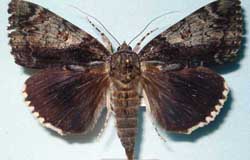
| ** 8794
Catocala lacrymosa;
Tearful Underwing, 60-82mm. |
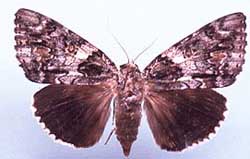
| ** 8794
Catocala lacrymosa;
Tearful Underwing, 60-82mm. |

| ** 8791 Catocala insolabilis; Inconsolable, 65-75mm. Fw light grey with blackish shading along inner margin. Antemedial and postmedial lines are thin. Hw fringe is very narrow and grey, becoming whiter toward the apex. Ventral surface clearly distinguishes insolabis, being almost completely black except for some white in basal area. Vernon A. Brou image. |

| ** 8792
Catocala vidua;
Widow; 70-80mm.
Fw ground colourlight grey with
distinguished dark arc running through top of reniform spot
to just below apex. There are heavy, dark anal & basal
dashes, connecting to dark median bar, running parallel to im. |

| ** 8793 Catocala maestosa; Sad Underwing, 78-98mm. Maesotsa is quite similar to, although usually larger than, vidua. Both have the dark arc from the costa, above the reniform spot, to the outer margin just below the apex. Maesotsa, however, lacks the dark bar, found on vidua, parallel to the inner margin. The reniform spot is brown and there is brown shading just outside the postmedial line. The hindwing fringe is white, narrow and heavily barred. |
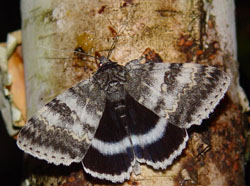
| ** 8803 Catocala relicta
;
Forsaken, White, Relict; 70-80mm:
Considerable variation with regard to black/white
concentrations on fws. |

| ** 8803 Catocala relicta ; Forsaken, White, Relict; 70-80mm: Considerable variation with regard to black/white concentrations on fws. Form clara: basal and subterminal areas predominantly white.Typical specimens have basal and subterminal areas with blackish scales. Black hws, with brilliant even white inner band and white fringe, are distinctive. June until October. |
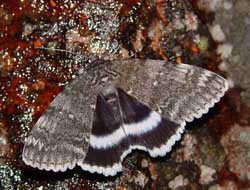
| ** 8803 Catocala relicta ; Forsaken, White, Relict; 70-80mm: Considerable variation with regard to black/white concentrations on fws. Form phrynia: evenly dusted with grey over entire forewing. Typical specimens have basal and subterminal areas with blackish scales. Black hws, with brilliant even white inner band and white fringe, are distinctive. June until October, poplars and willows |

| ** 8802 Catocala cerogama; Yellow-Banded; 70-80mm. Several different forms. Pm line distinct, dark and has elongate pair of projections. Pm and am lines meet inner margin in relative proximity. Closed subreniform spot lighter than surrounding areas, shaped a bit like an arrowhead with point toward body. Hws are distinctive. Jean-Benoît Duval image. |
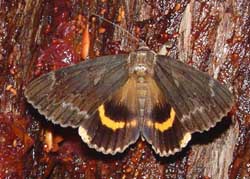
| ** 8802 Catocala cerogama; Yellow-Banded; 70-80mm.Form ruperti: Forewings are almost uniform grey-brown with white scales outlining subterminal line. The hindwings are distinctive. Tim Dyson image. |
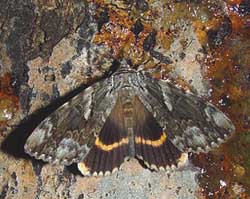
| ** 8802 Catocala cerogama; Yellow-Banded; 70-80mm.Form bunkeri: Forewings are dark in median and basal areas. Hw golden band is reduced in thickness. Basal hairs are brown instead of yellow. The hindwings are distinctive. Tim Dyson image. |

| ** 8822 meskei; Meske's Underwing; 65-75mm. Fws less distinctly marked compared to unijuga and some red-orange at hw apex and just inside fringe along outer margin in meskei that is lacking in unijuga. fw subreniform spot is opened or connected to the postmedian line. The hindwing postmedian band is nearly straight, turned in and tapering near the anal angle. Tim Dyson image. |

| ** 8821 semirelicta; Semirelict Underwing; wingspan: 65-75mm. Fw ground colour white with dark lines and shadings. Diffuse dark bar runs from center of basal area to outer margin a few mm above anal angle. Note regular dentation of st line. Inner black bar on lower wing usually terminates well before inner margin. The form "atala" has forewing that is uniformly grey. Unijuga is usually larger and has less contrasting black lines. Inner black bar on unijuga usually reaches inner margin. Tim Dyson image. |

| ** 8801 Catocala ilia; Ilia; wingspan: 65-82mm. Several different forms, most have characteristic white area in and around reniform spot. Diffuse dark arc running from this spot to just below apex. Subreniform spot squarish, concave inner and outer edges and elongated constriction connecting it to pml. White dots near fw om in character with the overall "contrasting" appearance. |
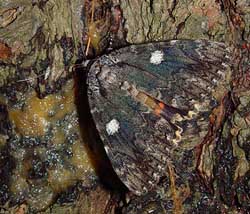
| ** 8801 Catocala ilia; Ilia; form conspicuaIn this form the entire reniform spot is heavily suffused with white scaling on an otherwise darker ground colour. Hence the form name "conspicua". Tim Dyson image. |
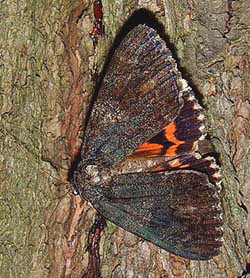
| ** 8801 Catocala ilia; Ilia; form satanasIn this melanic form the entire forewing, including the reniform spot is very dark. Hence the form name "satanas". The dark basal streak is still evident on this form. Tim Dyson image. |
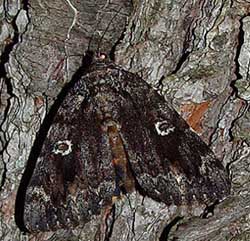
| ** 8801 Catocala ilia; Ilia; form normaniIn this semi-melanic form the entire forewing, excluding the reniform spot, is relatively dark. The brownish, kidney-shaped center of the reniform spot is outlined in white. The basal streak and subapical arc are still visible. Tim Dyson image. |

| ** 8808 luciana; Luciana Underwing, 70-80mm. Pale grey brown forewing with very distinct am & postmedial lines. Subreniform spot has elongated narrow "tail" that seems to open through postmedial line. Inner black band of hw does not reach inner margin. Fringe is checked and paler (almost yellow) than salmon ground colour. |

| ** 8771 Catocala piatrix ; Penitent, wingspan: 68-84mm. Fw: light-colored band/bar extending from light coloured, triangular subreniform spot along am line to costa. Brown, kidney-shaped reniform spot surrounded in pale grey, outlined in black, usually with distinct black along wing veins in a dark area outside the reniform spot. Hw: fringe lightly barred; lighter in color than deeper orange on rest of wing. |

| Catocala junctura; Joined Underwing; : 67-85mm. Fw dark brownish-gray to evenly powdered blue-grey w/o significant markings. Doubled reniform spot obscure. Thin, slightly darker am & pm lines run from costa to im, not widely spaced at im. Hw salmon or orange-pink with narrow inner black band turning sharply but not meeting dark-haired im, distinguishing it from unijuga. |

| ** 8805 unijuga; Once-married; 70-90mm. Fairly wide black inner band (almost reaching inner margin) in hw and very distinctive patterning in fw. Meskei tend to have narrower band and dustier (less distinct) looking forewing. Semirelicta tend to have inner bands terminating well before inner margins. Note very white fringe on both forewings & hindwings. Carroll Rudy image. |

| ** 8806 Catocala parta; Mother Underwing, 70-85mm. Black dashes in basal, subapical and anal areas help to identify this species. Hws may be yellow to yellowish-orange but more often are salmon-red. Note the face-head-like markings on the thorax. In the hindwing, the first (nearest the apex) black protrusion into the white fringe is "noticeably" larger than the others. |

| ** 8798 Catocala neogama; 70-85mm. Note brown head & thorax & larger size compared to C. palaeogama. Specimens slightly smaller than subnata, darker grey brown forewings, more pronounced markings. Neogama's hind tibia tend to be flattened and unevenly & sparsely spined while subnata's tibia are cylindrical with spines dense & uniform in distribution. Joe Garris photo. |

| ** 8797 Catocala subnata;
Youthful Underwing, 75-90mm.
Fws greyish white with blue-grey & light brown scales.
Usually have hindwings brighter
yellow than those of neogama. Neogama usually
have basal dash; absent in male subnata, but present in females. |

| ** 8796 Catocala nebulosa; Clouded; 75-86mm.> Prominent dark brown upper-half-basal patch extending to, ending at antemedial line. Apical area also tends to be brown, much darker than median area but not as dark as basal patch. The anal angle also has the darker brown scaling. The pm line is distinct near costa and inner margin, but becomes weak between the two. It meets inner margin in relative close proximity to am line. Closed subreniform spot is large and connects to the pm line via a thin line. |

| ** 8833 concumbens Sleepy Underwing or Pink Underwing,60-75mm). This brown thoracic collar is quite evident in this image as is the interruption in the pm line by the open subreniform spot. The white hindwing fringe is only lightly checked on the wing veins. The vibrant pink bans are distinct in colour and also in their relatively smooth contour. |

| ** 8832 Catocala cara;
Darling; 70-85mm.
Note deep maroon almost purple cast to fws, mixed with
very pale green. Lower half of am and pm lines is barely
visible. No distinctive bars or dashes. Two upper
"teeth" on pm line are thin and long.
The hindwing bands are pink. There is heavy black checking on the
off-white hindwing fringe. The relatively thick black median band of the
hindwing almost reaches the inner margin which is usually heavily
adorned with dark hairs. |

|
** 8834 amatrix Sweetheart Underwing; (wingspan 75-95mm). Very skittish, frequently hides in caves, under bridges, under tree bark, etc. by day, resting with head down. Hw patterning and colouration similar to that of C. concumbens, but large size (wingspan 75-95mm) and dark bar running from basal area to just below apex distinguishes C. amatrix. See large Catocala amatrix courtesy of Joan F. Rickert. |
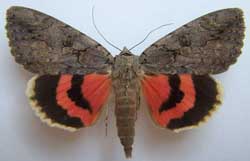
|
** 8834 amatrix form selecta
Sweetheart Underwing; (wingspan 75-95mm) |
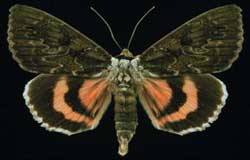
|
** 8834 amatrix form hesseli
Sweetheart Underwing; (wingspan 75-95mm) |

Catocala unijuga, courtesy of Joan F. Rickert, Taylor County,
Wisconsin,
September 03, 2006, id by Bill Oehlke.
Catocala serena July 28, 2006
Catocala unijuga August 26, 2006
Catocala clintoni July 9 2007
Catocala mira July 23, 2007
Catocala grynea July 23, 2007
Catocala ultronia July 23, 2007
RECORDS FOR CALUMET COUNTY, WISCONSIN, TOWN OF BROTHERTOWN, GOVERNMENT LOT #135, COURTESY OF CARROLL RUDY
------------------------
8779 Catocala serena 7-28-06 --out of range
8788 Catocala retecta 8-16-05 through 9-13-05
8788 Catocala retecta 8-5-06 through 8-18-06
8797 Catocala subnata 8-14-06
8798 Catocala neogama 7-26-06
8801 Catocala ilia 7-26-06
Catocala ilia 7-9-07 form conspicua
8802 Catocala cerogama 8-8-05, 9-18-05
Catocala cerogama 7-24-06 through 9-16-06 Aug --abundant
8803 Catocala relicta 8-9-05 to 9-15-05
8803 Catocala relicta 8-18-06 through 9-16-06 both white form '
and "normal' form in equal numbers
8805 Catocala unijuga 8-26-05 to 9-26-05
Catocala unijuga 8-9-06 --through 9-7-06
8806 Catocala parta 8-27-05 through 9-18-05
Catocala parta 7-25-06 through 9-7-06
Catocala parta 7-18-07
8822 Catocala meskei 8-5-06
8832 Catocala cara 9-13-04
Catocala cara 8-1-05 to 9-18-05
Catocala cara 8-2-06 through 9-16-06 ----abundant
8833 Catocala concumbens 9-3-04
Catocala concumbens 8-5-05 to 9-17-05
Catocala concumbens 8-1-06 through 10-2-06 --Abundant
8834 Catocala amatrix 9-3-04
Catocala amatrix 8-8-05 to 9-26-05
Catocala amatrix 8-9-06 till 9-6-06
Catocala mira 7-8-07
8864 Catocala grynea 9-22-04
Catocala grynea 7-31-05
Catocala grynea 7-24-06 -- Aug 18-- abundant
Catocala grynea 7-8-07
8857 Catocala ultronia 8-3-04
Catocala ultronia 7-29-05
Catocala ultronia 7-23-06 through 9-1-06 --abundant
Catocala ultronia 7-8-07
8867 Catocala blandula 7-20-06 7-25-06
8872 Catocala clintoni 7-9-07
++++++++++++++++++
Taylor County sightings by Joan F. Rickert:
Catocala amatrix August 30
Catocala unijuga September 3
Medfor (Taylor County) sightings by Loretta Kuse and Hildegard Kuse:
8833 Catocala concumbens 8-8-07
8802 Catocala cerogama 8-8-07

Catocala cerogama and Catocala concumbens sipping cider,
August 8, 2007, courtesy of Loretta Kuse and Hildegard Kuse.
Ascalapha odorata
Use your browser "Back" button to return to the previous page.
Return to Canadian Index
Return to Main Index
Enjoy some of nature's wonderments, giant silk moth cocoons. These cocoons are for sale winter and fall. Beautiful Saturniidae moths will emerge the following spring and summer. Read Actias luna rearing article. Additional online help available.
Eggs of many North American Saturniidae species are offered during the spring and summer. Occasionally summer Actias luna and summer Antheraea polyphemus cocoons are available. Shipping to US destinations is done from within the US.
This page is brought to you by Bill Oehlke and the WLSS. Pages are on space rented from Bizland. If you would like to become a "Patron of the Catocala Site", contact Bill.
Please send sightings/images to Bill. I will do my best to respond to requests for identification help.
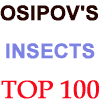
|
butterfly to the left, a link to many worldwide insect sites. |
Contributions to a Check List of the Lepidoptera of Wisconsin
(Macrolepidoptera Families: Thyatiridae, Drepanidae, Geometridae, Epiplemidae, Hesperiidae, Papilionidae, Pieridae, Lycaenidae, Riodinidae,
Nymphalidae, Mimallonidae, Lasiocampidae, Apatelodidae, Saturniidae, Sphingidae, Notodontidae, and Noctuidae; also including: Hepialidae,
Cossidae, Attevidae, Yponomeutidae, Zygaenidae, Limacodidae, and Thyrididae)
By Hugo L. Kons Jr., Robert J. Borth, and Thomas S. Barina
Posted on the Web 24 August 2007
8770 Catocala innubens *
8771 Catocala piatrix *
8773 Catocala epione *
8775 Catocala antinympha *
8776 Catocala coelebs *
8778 Catocala habilis *
8779 Catocala serena *
8781 Catocala judith *
8784 Catocala obscura *
8785 Catocala residua
8788 Catocala retecta *
8791 Catocala insolabilis * [Examined by RJB, col. J. Parkinson]
8792 Catocala vidua *
8793 Catocala maestosa *
8794 Catocala lacrymosa * [Examined, col. W. Seiker]
8795 Catocala palaeogama *
8796 Catocala nebulosa *
8797 Catocala subnata *
8798 Catocala neogama *
8801 Catocala ilia *
8802 Catocala cerogama *
8803 Catocala relicta *
8805 Catocala unijuga *
8806 Catocala parta *
8808 Catocala luciana *
8817 Catocala briseis *
8821 Catocala semirelicta *
8822 Catocala meskei *
8829 Catocala junctura * [Examined, col. W. Seiker]
8832 Catocala cara *